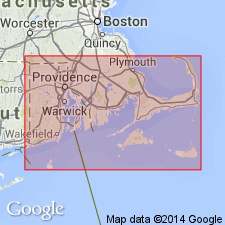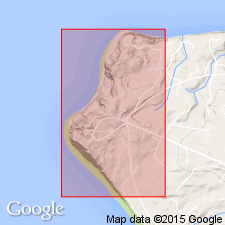
- Usage in publication:
-
- Aquinnah conglomerate*
- Modifications:
-
- Original reference
- Dominant lithology:
-
- Conglomerate
- AAPG geologic province:
-
- New England province
Summary:
Pg. 160. Aquinnah conglomerate. Semiconsolidated quartzose conglomerate with numerous cetacean bones. Thickness 0 to 1.5 feet. In previous reports called "osseous conglomerate," and referred to Miocene, but it contains the remains of a Pleistocene horse. Underlies Dukes boulder bed at Gay Head Cliffs fold, on Marthas Vineyard, the only place it is known to occur. Is nonglacial and preglacial, and probably is an old stream gravel. Aquinnah is Indian name for Gay Head.
Source: US geologic names lexicon (USGS Bull. 896, p. 64-65).

- Usage in publication:
-
- Aquinnah conglomerate*
- Modifications:
-
- Overview
- AAPG geologic province:
-
- New England province
Summary:
Pg. 543. Aquinnah conglomerate (Pleistocene). Discussion of beginning of Pleistocene in eastern United States. Inland along Coastal Plain, not only in South Atlantic States but occurring discontinously from Cape Cod district to lower Mississippi River, are extensive areas of highly quartzose gravel and sand (and along Gulf Coast, silt and clay). These sediments, on Atlantic Coast at least, indicate selective weathering and deposition by streams. They have not been studied as a whole, but throughout long distances they appear to have same general character. They are known under various regional or local names, such as Citronelle formation, Bryn Mawr gravel, Beacon Hill gravel, Manetto gravel, and Aquinnah conglomerate [known only to occur at Gay Head Cliffs fold on Marthas Vineyard, southeastern Massachusetts].
Source: US geologic names lexicon (USGS Bull. 1200, p. 121-122).
For more information, please contact Nancy Stamm, Geologic Names Committee Secretary.
Asterisk (*) indicates published by U.S. Geological Survey authors.
"No current usage" (†) implies that a name has been abandoned or has fallen into disuse. Former usage and, if known, replacement name given in parentheses ( ).
Slash (/) indicates name conflicts with nomenclatural guidelines (CSN, 1933; ACSN, 1961, 1970; NACSN, 1983, 2005, 2021). May be explained within brackets ([ ]).

